|
|
|
Sort Order |
|
|
|
Items / Page
|
|
|
|
|
|
|
| Srl | Item |
| 1 |
ID:
147326
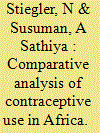

|
|
|
|
|
| Summary/Abstract |
The aim of this article is to show a comparative analysis of contraceptive use in areas of traditionally high fertility that have gone through profound changes. Data have been taken from the latest Demographic and Health Surveys (DHS). Logistic regression models were adopted for four selected representative countries, namely Egypt, Mali, Namibia and Niger. There were two selection criteria: data should be recent, and selected countries should have high (Egypt 57.4%; Namibia 46.4%) or low (Mali 7.5%; Niger 10.0%) contraceptive use. The probability of using contraception when a woman has had one to four children is 2.4 times higher than when they have had no children. Contraception data are always gathered at a point of time, but cross-sectional data are not sufficient to understand all the mechanisms hidden behind contraceptive use. Different contraceptive behaviours need good estimation tools to develop specific family planning programmes.
|
|
|
|
|
|
|
|
|
|
|
|
|
|
|
|
| 2 |
ID:
149485
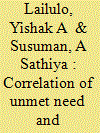

|
|
|
|
|
| Summary/Abstract |
A few key factors affecting usage of all methods and contraceptive discontinuation among women whom are currently married in Ethiopia are discussed. What are the factors affecting women’s contraceptive use? The aim is to explore the two regions on the basis of high total fertility rate (TFR) regions (Oromiya (5.6) and Southern Nations, Nationalities, and People’s Region (SNNPR) (4.9)) in the Ethiopian demographic and health survey (EDHS) 2011. A descriptive and comparative study using the quantitative research method is chosen to address the above research question. The study findings show that the contraceptive discontinuation rate for users of all types of methods is 37%. The highest women’s discontinuation rate is for the pill which is 70% due to side effects.
|
|
|
|
|
|
|
|
|
|
|
|
|
|
|
|
| 3 |
ID:
149748


|
|
|
|
|
| Summary/Abstract |
In 2010, according to the sixth Chinese census, the sex ratio at birth (SRB) was 118 males for every 100 females. The global SRB average is about 105. Thus, the gap between 118 and 105 is made up of “missing girls.” Scholars present three main explanations for the skewed SRB statistic: sex-selective abortion, infanticide and delayed or late registration. Most studies take a demographic and cultural approach to explain the high SRB. However, we believe the story of the “missing girls” is also an administrative one and adopt the street-level bureaucrat theory of policy implementation to explain the pervasiveness of late registration in rural China. We use descriptive statistics derived from the 1990, 2000 and 2010 census data to identify the “missing girls.” We believe the combination of late registration and unreported births may point to a larger proportion of “missing girls” than previously reported from the SRB statistic.
|
|
|
|
|
|
|
|
|
|
|
|
|
|
|
|
| 4 |
ID:
128517
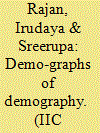

|
|
|
| 5 |
ID:
178867
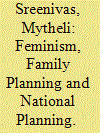

|
|
|
|
|
| Summary/Abstract |
This paper identifies family planning as a key arena of women’s movement activity during the 1950s and early 1960s. Focusing on the All India Women’s Conference (AIWC) and the Family Planning Association of India (FPAI), I argue that organised women helped to make family planning a component of national planning for development. While they joined other policymakers to promote the idea that controlling population was necessary for the new nation’s economic progress, the AIWC and FPAI also made a distinct case for family planning as a part of national development that was conducted by women, for women. In doing so, they created a new terrain of public activity for middle-class family planners, who claimed to mediate between ordinary women and national development goals. However, the women targeted for family planning services did not always acquiesce to this nation-building logic, and sometimes offered alternative interpretations of their reproduction. The result was often a tense negotiation between the family planners who claimed to speak for women, and the women who refused their claims.
|
|
|
|
|
|
|
|
|
|
|
|
|
|
|
|
| 6 |
ID:
141718


|
|
|
|
|
| Summary/Abstract |
The article tracks the evolution of the family planning programmes in India and China and the conceptual linkages between the two. This comparison, in turn, serves as an entry point for studying the following:
The role that the family plays in becoming the site of governance and deploying state-led capitalism in the two countries.
The assumptions behind the development trajectories in both countries.
What are the ways in which the policies amplified patrilineal hierarchies within families to produce the disturbing outcome of the missing girl child—this even as the family planning policies became constrained as they were acting within a cultural milieu of patriarchy.
The article uses studies and commentaries across disciplines, such as, historical demography and anthropology to situate its arguments. The conclusion it attempts to put forth is that the small family norm was operationalised in various differing ways in both states, and yet the commonalities that arose were the following:
The declining sex ratio in both states as an immediate repercussion of the enforcement of the small family norm.
The structuring of the health services around the family planning operations.
The small family norm becoming an end in itself, as a mode of reaching a level of development akin to the West, and as an ethic for modernising nations.
|
|
|
|
|
|
|
|
|
|
|
|
|
|
|
|
| 7 |
ID:
180029
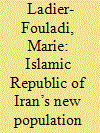

|
|
|
|
|
| Summary/Abstract |
After dropping rapidly and steadily over two decades, fertility in Iran stabilized between 2001 and 2011 at around 1.9 to 2 children per woman, before starting to rise slightly between 2012 and 2016, then falling fairly quickly. This coincided with the implementation of the Islamic Republic’s new population policy, with its aggressive and coercive measures, one of whose goals was to reverse the downwards trend in fertility. Given changes in proximate and remote determinants of fertility in Iran, and the decline in fertility since 2016, it is assumed that this new population policy triggered a reduction in intervals between births between 2012 and 2015, leading to a slight rise in the fertility of already married couples. The other latent objective of the Islamic Republic’s new population policy is to drive Iran’s population up to 150 million inhabitants in the near future. This is utopian given Iran’s demographic dynamics, but it conceals the political and ideological goal of asserting Iran’s demographic and geopolitical significance within the region, by drawing on a novel immigration policy to make up for its low fertility.
|
|
|
|
|
|
|
|
|
|
|
|
|
|
|
|
| 8 |
ID:
128880
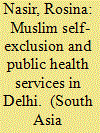

|
|
|
|
|
| Publication |
2014.
|
| Summary/Abstract |
This study is an account, largely based on field research, of how Muslims in Delhi experience the public healthcare sector. It identifies how negative memories of the Indian Emergency and sterilisation campaigns of that time may still get recalled today whenever any untoward incident happens concerning Indian Muslims in relation to public health services. The research seeks to identify to what extent this kind of historical memory translates into perceptions of disadvantage that then gradually initiate a process of self-exclusion, reinforcing a spiral of disadvantage.
|
|
|
|
|
|
|
|
|
|
|
|
|
|
|
|
| 9 |
ID:
152351
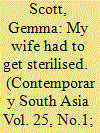

|
|
|
|
|
| Summary/Abstract |
Existing scholarship on the Emergency’s sterilisation programme largely excludes women’s experiences, echoing the Shah Commission of Inquiry’s focus on men’s complaints against the government in its published reports. This paper re-orients historical understandings of this programme to account for female sterilisation during 1975–1977. By reading the Commission’s extensive collection of archived files against the grain, I use the male-dominated archive to illuminate the gendered nature of this policy and its effects on India’s women. Against dominant perceptions that the Emergency’s sterilisation programme focused entirely on vasectomy, this paper discusses instances where women were critical in families’ attempts to negotiate the regime’s coercive measures. It also analyses the negative impacts of coercion on the ‘girl child’ and the consequences of the Emergency’s single minded focus on sterilisation for the Mother and Child Health programme. Through these discussions I argue that such measures exacerbated existing gendered biases. In doing so, this paper challenges dominant understandings of the Emergency’s sterilisation programme and explores women’s experiences.
|
|
|
|
|
|
|
|
|
|
|
|
|
|
|
|
| 10 |
ID:
084277


|
|
|
| 11 |
ID:
189416


|
|
|
|
|
| Summary/Abstract |
This article compares work-family conflict (WFC) among more than 2000 married Israeli Jewish and Arab women. The data was taken from Israel Social Surveys and included varied life-course variables that allowed to explore in depth relationships between WFC and family formation. Our findings reveal that Arab women experienced WFC more than Jewish women. Delaying first marriage and first birth and having more children are related to higher WFC. Furthermore, WFC was associated positively with women’s wage and work experience. The implications of the research and recommendations for public policymakers are discussed.
|
|
|
|
|
|
|
|
|
|
|
|
|
|
|
|
| 12 |
ID:
122667


|
|
|
| 13 |
ID:
190162
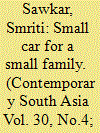

|
|
|
|
|
| Summary/Abstract |
The Maruti Suzuki joint venture between the Government of India and the Japanese Suzuki Motor Corporation in 1983 launched India’s first ‘people’s car’ – the Maruti 800. This article argues that the conceptualisation and promotion of the Maruti 800 as the ideal car for a small, middle class family revealed subtle continuities with the controversial family planning programme of the state which had reached its peak during the internal ‘Emergency’ of 1975. By associating the Maruti 800 – an object of aspiration for an emerging middle class and of at least potential mass consumption – with a small family, the state reiterated its message of population control albeit subliminally. The article further suggests that the adoption of Japanese management practices at Maruti, which laid emphasis on hard work and loyalty to the company-family, was in line with Prime Minister Indira Gandhi’s desire to enforce discipline and enhance labour productivity, a notion also vocalised during the Emergency. Finally, the article illustrates how the ‘people’s car’ project placed the Indian state as the ‘driver’ of middle class aspirations and mobility in 1980s’ India, a full decade before the liberalisation reforms of 1991.
|
|
|
|
|
|
|
|
|
|
|
|
|
|
|
|
| 14 |
ID:
167089


|
|
|
|
|
| Summary/Abstract |
In December 1959, the newly-constituted Pakistan Academy of Rural Development received permission to create a ‘laboratory’, that is, to conduct experiments in rural development upon peasants in Comilla, East Pakistan. This paper explores the enmeshing of post-colonial state formation and Cold War American development practices through an examination of how the Academy’s built environments, everyday practices and discourses were shaped by agricultural and contraceptive technologies. It examines how the Academy transformed a Gandhian ashram into a display and distribution centre for these technologies, and how technologies informed the Academy’s discourses on peasant religiosity and shaped peasant understandings of state and empire.
|
|
|
|
|
|
|
|
|
|
|
|
|
|
|
|
| 15 |
ID:
104032
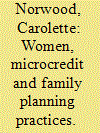

|
|
|
|
|
| Publication |
2011.
|
| Summary/Abstract |
This paper examines the influence of informal banking club participation on family planning practices in rural Ghana. Research from Asia suggests that family planning practices are improved by club participation. This study examines this thesis in an African context, using rural Ghana as a case study. A sample of 204 women (19 years and older) was drawn from Abokobi village, Ghana. Multivariate analyses of direct, mediating and moderating effects of women's demographic background characteristics, membership status and length, and women's empowerment status as predictors of family planning practices are assessed. Findings suggest that club membership and membership length is not associated with family planning practices; however, age, education level, number of children and empowerment status are.
|
|
|
|
|
|
|
|
|
|
|
|
|
|
|
|
| 16 |
ID:
174888


|
|
|
|
|
| Summary/Abstract |
This article aims to examine the relationship between women’s household bargaining power and their adoption of modern contraception in post-Soviet Tajikistan using the 2012 Demographic and Health Survey. The study uses direct measures of bargaining weights: a woman’s ability to make decisions about her own health care; visits to her family or relatives; and contraceptive use. An additional measure defining a woman’s financial capability to receive medical treatment for herself is added in the analysis to understand its correlation to women’s contraceptive-use behaviour. The probability of using contraception is 187 percentage points higher for a woman who has both control over her own health care and financial means to get medical help than a woman who does not have these choices. Having a say in the decision to control births increases the probability of using contraception by 98 percentage points. Our findings reveal that certain aspects of a woman’s household decision-making and financial freedom are relevant to explain her contraceptive-use behaviour.
|
|
|
|
|
|
|
|
|
|
|
|
|
|
|
|
|
|
|
|
|